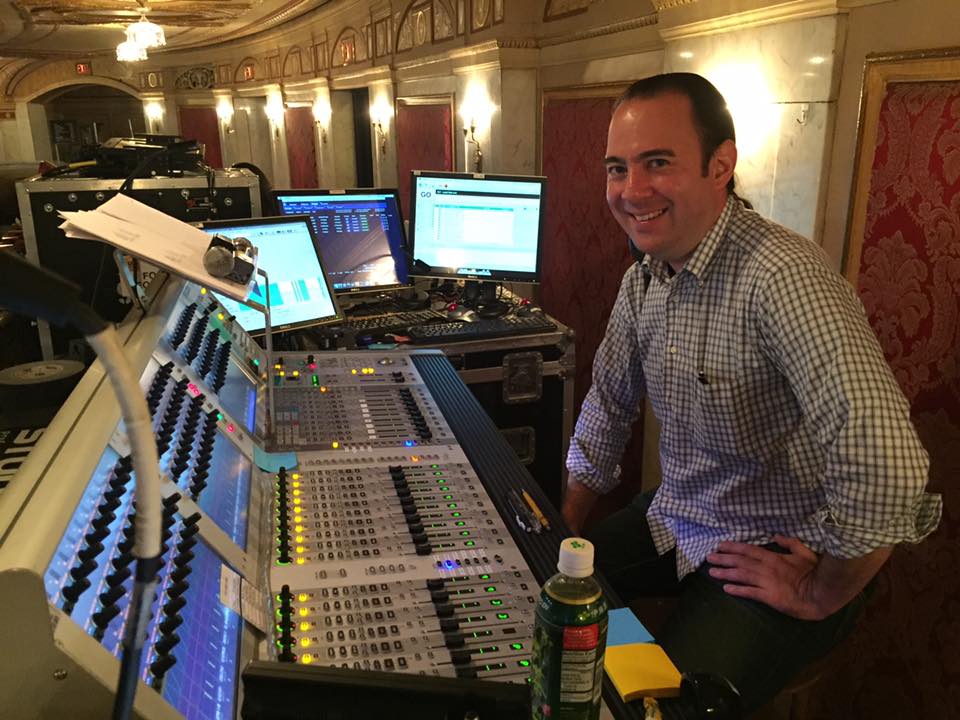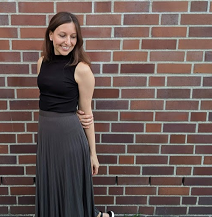Spotlight on Kai Harada: Sound Designer Edition
In Theatre Trip’s “Spotlight On” series, we’re chatting with some of the most interesting and influential people in the theatre industry. And today we’re doing a special feature on Kai Harada, an award-winning sound designer from New York, New York!
Kai Harada has designed the sound for too many productions to easily count. But he is probably best known for his Tony + Drama Desk Award winning sound design for The Band’s Visit. Additionally, he was nominated for a Drama Desk Award for his work on Fun Home. And he was also nominated for both Tony and Drama Desk Awards for the revival of Follies. So he’s a pretty great guy to look up to you if you’re considering a career in sound design!
So what initially got you involved with theatrical sound design?
“Both of my parents are classical musicians- mom’s a violinist and was a music teacher, dad’s a cellist and was in a string quartet for many years. So my childhood was spent at classical concerts, sometimes backstage, sometimes in the recording booth. I trained as a classical pianist for ten years. But I also knew that the professional musician lifestyle was not something I wanted. And when I was young I thought that I might become a classical recording engineer.
In junior high (I grew up in CT) a friend of mine said, “Hey, do you want to hang some lights in the theatre?” And as someone who enjoyed the technical side of things, I said yes. And slowly it dawned on me that there was a whole side of technical theatre that involved sound. Even at a young age I felt more drawn to the idea of sound reinforcement- of microphones and loudspeakers and how to make things all work together, rather than composing music or making sound effects for plays. I continued to do more work in high school and college theatre, then worked one summer at a local sound company that rents out equipment to Broadway shows.
From there, I met some professionals, and soon after that I landed my first assistant gig with renowned sound designer Tony Meola. I don’t think it even occurred to me until that moment that this was an ACTUAL career path. Growing up I saw maybe two musicals on field trips, but that was it. At the tender age of nineteen I really didn’t know what I wanted to be when I grew up. Now I’m trapped; I don’t know what else I could do.”
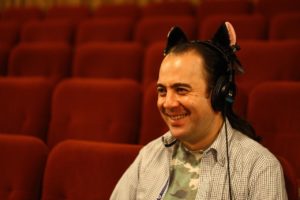
What do you enjoy most about your career?
“One of the things I enjoy the most is also what can be the most frustrating: other people. I enjoy the collaborative nature of a great creative and design team, how we can all work together to make the best possible product- negotiating speaker positions versus scenery and costumes and hats versus microphones, and working with the composer and orchestrator to ensure that we are delivering their vision in a coherent and accurate way. Unfortunately, there are occasionally those shows on which there is less cooperation, and more personalities and egos to fend off. And the psychologist part of me takes some sick pleasure in identifying how best to communicate with difficult people.
The thing that I enjoy the most is being able to make a show sound *right*. I enjoy overcoming the physical and acoustical challenges of a space, ensuring that every audience member gets the best possible auditory experience, and making something that I am proud of. I’ve been very fortunate to have worked on some fantastic projects, from the revival of “Follies” to “Fun Home” to “The Band’s Visit” to “On the Town,”. And although each of those shows had their individual challenges, I was always very proud of the work my team and I did.”
“Everyone has a different path; everyone has different strengths and weaknesses; and those may shift how a path into professional sound design actually happens.”
What has been the biggest challenge you’ve had to face in your career so far?
“At this point in my life, I think the biggest challenge I’ve faced is the realization that I’ve sacrificed so many other parts of my life in favor of my career. Many people in the arts do this, obviously, and those people can become quite successful. I’m very pleased with the trajectory of my career: I’ve done some wonderful projects with some fantastic people. I have a couple of awards. I have interesting projects lined up. And I have a great team of people I can rely on.
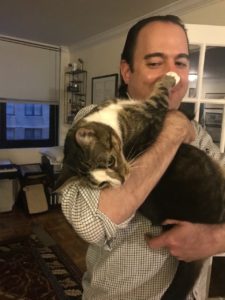 But I have an expensive apartment in New York that I don’t spend enough time in, I have a beautiful cat that I miss terribly when I’m out of town, and I’ve missed important family or friend events to be able to work these ridiculous hours. So I’ve struggled a lot with the work/life balance. I know I am incredibly fortunate to have a career that I am so passionate about. So on one hand it makes me a very lucky person; but that said, it comes with a price.”
But I have an expensive apartment in New York that I don’t spend enough time in, I have a beautiful cat that I miss terribly when I’m out of town, and I’ve missed important family or friend events to be able to work these ridiculous hours. So I’ve struggled a lot with the work/life balance. I know I am incredibly fortunate to have a career that I am so passionate about. So on one hand it makes me a very lucky person; but that said, it comes with a price.”
What type of education would you say is necessary for becoming a successful sound designer?
“I’m torn on this one. There’s a trend with people who come from undergraduate or graduate programs to have a very stratified and codified view of the world, including our industry and how sound design is part of that. And I spend a lot of time trying to break those views: that’s not how the world works. Someone’s instructor may say, “You have this project when you’re a third year, you do this when you’re graduating, and then you move to New York where you’ll work as an assistant for two years and after that you should be mixing a show.” Everyone has a different path; everyone has different strengths and weaknesses; and those may shift how a path into professional sound design actually happens.
I’m not sure if it’s because most of my training was from books and talking to people, rather than courses on sound design, but I do tend to find that many people who had to learn on their own and experiment have better instincts than people who come from educational programs. I do give lectures from time to time. And the first thing I say is to not *completely* ignore your instructor, but do understand that there are many ways to do sound, just as in life. There’s no formula that makes you successful or not. But the first rule I usually give is, “Don’t be an asshole.” Personality is everything. I can teach about sound, but I can’t teach someone how to be a human being. None of us work in a vacuum; we have to collaborate and cooperate and compromise.
Oh, and music. Understand music. Read music. Maybe play some music. FEEL music. Go listen to some music you don’t like. Figure out if there’s anything you can take away from it. Go listen to some crappy band in a club, then go to Carnegie Hall. Pay attention to what the world around you sounds like.”
“At the end of the day, no one cares if your sound system is made up of NRT-5 or JAL-10 speakers; they just want their show to elicit a specific feeling.”
What are some common myths about your profession?
“There is an old myth is that sound designers contributed to the downfall of the American musical, by using microphones and making things louder. But what people failed to realize is that shows became more pop/rock-based. Additionally, actors became less theatrically trained, theatres became less acoustically friendly, and the noise floor in the theatre went up. The solution, in many cases, was to make the show louder. But that was a reaction, not an action.
A related myth that’s more common these days is that we have total autonomy over the sound of a show. The myth that we work in our own little bubble, and if a show doesn’t sound good, it is *solely* our fault. But we have many people that we answer to. It might be a director who may have hired us, a composer who has a specific vision in his or her head, an overzealous orchestrator, a choreographer who has lost a fair amount of hearing, or a producer who pays our salaries. They all contribute to the cauldron of notes we might get. And it’s our job to responsibly accommodate or at least facilitate a conversation between departments to make sure we are all heading for the same goal.
There is a tendency for shows to be written with the idea that a sound designer can just turn everything up. And in many cases we can. But not all composers and orchestrators always understand that sometimes, less is more. You can’t always have a screaming electric guitar phrase at the same time as a vocal line. The sounds are both in the same frequency range and a listener’s ear can’t accurately parse those two elements. And just because something sounds passable on a demo recording from a studio setting, it doesn’t mean that it will always translate to the live realm.”
“Understand music. Read music. Maybe play some music. FEEL music. Go listen to some music you don’t like. … Go listen to some crappy band in a club, then go to Carnegie Hall. Pay attention to what the world around you sounds like.”
Is there a particular book that you think all aspiring sound designers should read?
“Not really. But I can say that, in addition to learning a fair bit about music and how to communicate, that language, psychology and sociology aren’t bad topics to study. Like I’ve said, so much of what ANY designer has to do is collaborate, cooperate, and sometimes translate- e.g. what does it mean when a director says, “I want this to sound more blue?” It’s up to the sound designer to figure that out.
At the end of the day, no one cares if your sound system is made up of NRT-5 or JAL-10 speakers; they just want their show to elicit a specific feeling. Learning how to interpret people’s words and subtext can be incredibly valuable. Realizing that everyone has an ego, and everyone has insecurities, can also aid in identifying what makes other people tick.”
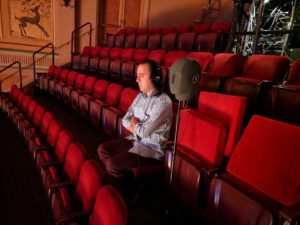
What are the biggest differences between working in the NYC theatre scene vs working in other cities?
“With the exception of Tokyo, New York has the best food choices and availability, especially after rehearsal or performances. London’s come a long way, and there are a few cities in the United States that are getting better. My father, who toured as a classical musician, always warned me about some cities in the middle of America and how difficult it was to find a suitable snack after a performance- and dammit, he was right!
More seriously, though, compared to other American cities, there is a “get it done” attitude and an alacrity that exists with New Yorkers that I prefer. But that pales in comparison with experiences I’ve had in Australia and Japan. The pace of life in a lot of other American cities tends to be a bit slower. But I’ve gotten used to the brusque efficiency of the New York metropolitan area.”
Is there a particular musical that you would love to design the sound for one day?
“I’m a big fan of old-school musicals with huge orchestras. “Follies” had twenty-seven (I think) and “On the Town” had twenty-eight. I do appreciate the challenges a smaller-sized orchestra with more electronics can present. But there’s something so visceral about hearing a big-for-Broadway orchestra play a gorgeous score. That said, if someone composed a really innovative musical with a LOT of electronic instruments that called for some really cool spatialization, I’d be all over that, too.”
What’s next for you?
“Vacation (I don’t know where yet). And Netflix.”
What did you think of this interview with Kai Harada?
Are any of you working as or aspiring to be a sound designer? We would love to hear all about it in the comments below! And in in the meantime, you can check out even more of our interviews with inspiring people in the theatre industry!
Learn More:
Kai Harada has also put together an amazingly comprehensive sound handbook➝, so if you are at all serious about a career in sound design, you should give it a read for sure!
Want to stay in the loop with all things related to musical theatre?
Author: Stacy Karyn
Stacy Karyn is the founder of Theatre Trip, author of The Thespian’s Bucket List, and creator of The Cast Album List. She holds a BA in theatre, a TESOL drama certificate, and has worked and interned with Broadway and Off-Broadway theaters.

